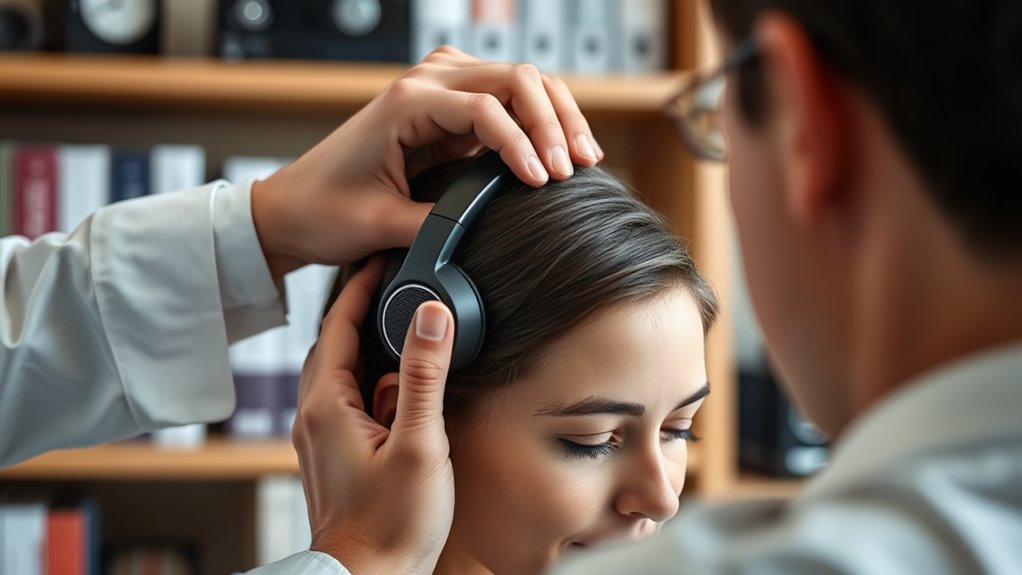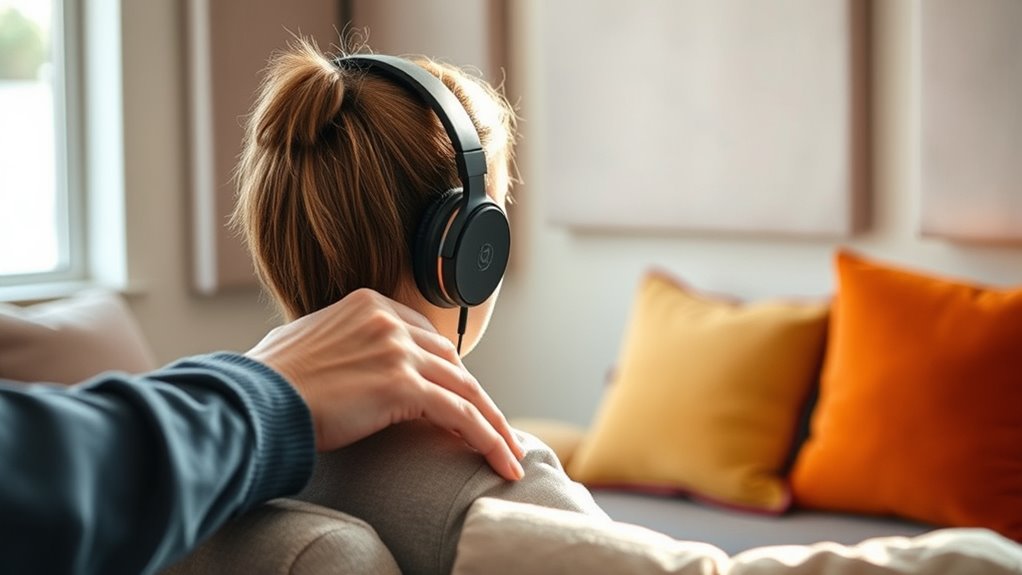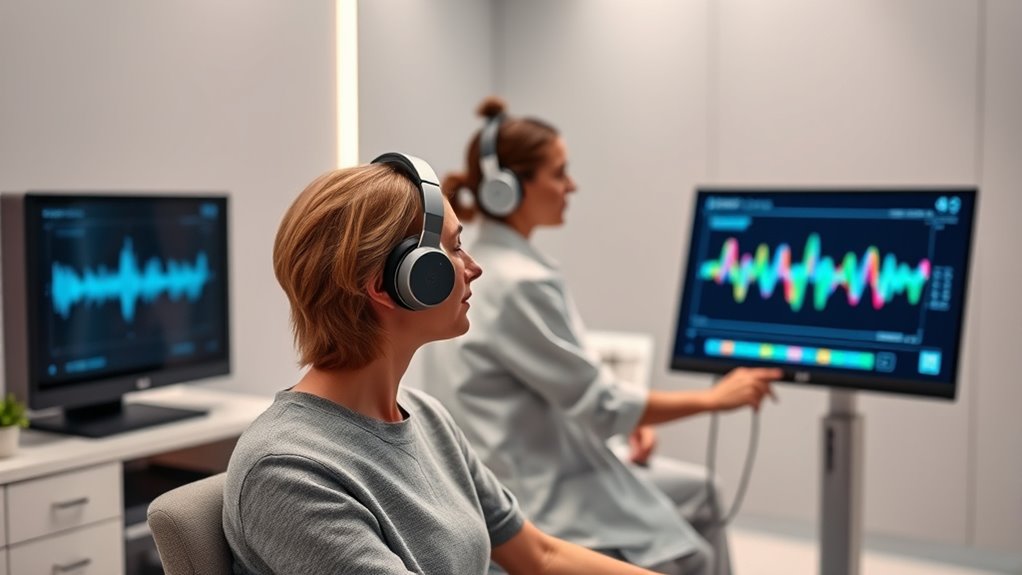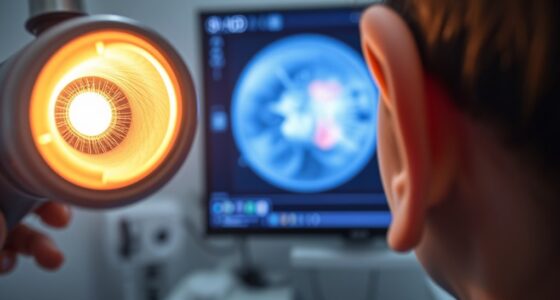Effective hyperacusis management combines sound therapy that gradually desensitizes your ears, cognitive-behavioral therapy to reduce anxiety, lifestyle changes like avoiding loud environments, and, when needed, medications for related symptoms. Using sound enrichment devices and hearing protection can help you habituate to sounds safely. Emerging treatments like neuroplasticity-based approaches show promise. For personalized guidance, exploring more about these evidence-based options will help you find the right strategies to improve your sound tolerance.
Key Takeaways
- Sound therapy with gradual, gentle sound exposure promotes neural habituation and improved sound tolerance in hyperacusis management.
- Cognitive-behavioral therapy effectively reduces sound-related anxiety and maladaptive emotional responses.
- Multimodal approaches combining sound therapy, psychological strategies, and lifestyle modifications yield the best evidence-based outcomes.
- Pharmacological options are supportive but not primary treatments; medications address associated symptoms rather than hyperacusis directly.
- Personalized, holistic interventions guided by healthcare professionals optimize treatment efficacy and long-term adaptation.
Sound Therapy Approaches for Hyperacusis

Sound therapy approaches are commonly used to help manage hyperacusis by gradually reducing sensitivity to sound. You might explore musical therapy, which uses gentle, calming sounds or music to desensitize your ears over time. This method involves listening to carefully selected sounds at comfortable levels, helping your brain adapt to everyday noises. Environmental noise management is also essential; it involves controlling exposure to loud or unpredictable sounds, often through sound masking devices or filtered sound environments. These techniques aim to retrain your auditory system, making everyday sounds less overwhelming. Consistent, guided exposure helps your ears become more tolerant, reducing discomfort and improving your overall sound experience. Understanding layer concepts can enhance the development of tailored sound therapy strategies, optimizing their effectiveness. Sound therapy provides a structured, gradual approach to overcoming hyperacusis.
Cognitive-Behavioral Therapy and Psychological Interventions

Cognitive-behavioral therapy (CBT) and psychological interventions target the mental and emotional factors that contribute to hyperacusis. These strategies aim to change negative thought patterns and reduce anxiety related to sound sensitivities. You’ll see improved outcomes when addressing these psychological mechanisms directly, leading to better overall management of hyperacusis. Incorporating relationship dynamics into therapy can further enhance emotional resilience and coping skills.
Psychological Mechanisms Addressed
Since hyperacusis often involves heightened emotional responses and maladaptive thought patterns, psychological interventions target these underlying mechanisms to reduce discomfort. You learn to improve emotional regulation, helping manage anxiety and frustration associated with sound sensitivity. Techniques also help shift your attentional focus away from perceived threats, reducing hypervigilance. Key mechanisms addressed include:
- Developing skills to modulate emotional reactions
- Reframing negative thoughts about sound exposure
- Enhancing awareness of maladaptive attention patterns
- Cultivating mindfulness to stay present and reduce avoidance behaviors
- Understanding how contrast ratio influences perceived image quality and helps create an optimal viewing environment
Effectiveness and Outcomes
Research shows that psychological interventions like Cognitive-Behavioral Therapy (CBT) can considerably reduce hyperacusis-related distress. These therapies target auditory processing issues by helping you reframe negative thoughts and develop coping strategies. As a result, they promote neuroplasticity enhancement, allowing your brain to adapt and recalibrate its response to sound stimuli. You may notice improvements in sound tolerance and a decrease in sound sensitivity over time. The outcomes of CBT and related interventions vary but often include reduced anxiety, better emotional regulation, and improved quality of life. While not a cure, these approaches can markedly diminish hyperacusis symptoms by addressing the psychological factors and neural pathways involved in auditory processing. Incorporating sound recording techniques during therapy sessions can also support gradual sound exposure and desensitization. Consistent engagement with therapy increases the likelihood of lasting, positive outcomes.
Use of Hearing Protection and Sound Enrichment Devices

Hearing protection and sound enrichment devices can play a vital role in managing hyperacusis. You need to understand how effective protective gear is and when to use it to prevent discomfort. Additionally, sound enrichment strategies can help desensitize your ears and improve your overall tolerance to noise. Incorporating automation technologies into treatment plans can further enhance personalized approaches to hyperacusis management.
Protective Devices Effectiveness
Protective devices such as hearing protection and sound enrichment tools can substantially reduce the discomfort caused by hyperacusis. Noise canceling devices, in particular, are effective at diminishing background sounds, providing relief. Earplug efficacy varies depending on design and fit, but well-fitted earplugs can markedly lower sound levels without muffling important cues. While these devices help manage sensitivity, their effectiveness depends on consistent use and proper application. Keep in mind:
- Proper fit is essential for ideal noise reduction
- Noise canceling devices can target specific frequencies
- Earplugs offer portable, immediate relief
- Overuse may lead to dependence or hearing issues
- The father-daughter bond exemplifies the importance of support and understanding in emotional well-being.
Sound Enrichment Strategies
Sound enrichment strategies combine the use of hearing protection devices with carefully curated sound environments to help manage hyperacusis. By incorporating sound masking and environmental noise, you can gently desensitize your ears and reduce sensitivity. Using sound masking devices, like white noise machines, creates a consistent background sound that diminishes the impact of sudden or loud noises. Environmental noise, when properly managed, can provide a calming auditory setting that promotes habituation. Here’s a quick overview:
| Strategy | Purpose |
|---|---|
| Sound masking | Diminishes startling sounds and eases discomfort |
| Controlled environmental noise | Builds tolerance and reduces hyperacusis symptoms |
| Hearing protection devices | Prevents overstimulation during exposure |
| Curated sound environments | Provides consistent, soothing background noise |
| Gradual exposure | Encourages ear desensitization safely |
Additionally, selecting the appropriate sound enrichment devices can optimize therapy outcomes and ensure comfort during treatment.
Pharmacological Treatments and Medication Options

While there is no universally approved medication specifically for hyperacusis, some drugs are used to manage associated symptoms or co-occurring conditions. These medications can help reduce anxiety, depression, or pain linked to sound sensitivity. However, you should be aware of potential issues, such as:
- Medication side effects, like drowsiness or dizziness
- Drug interactions that may affect treatment effectiveness
- The risk of dependency with certain medications
- Variability in individual responses to drugs
Many clinicians prescribe antidepressants or anti-anxiety medications, but their effectiveness varies. Always discuss potential risks, including medication side effects and drug interactions, with your healthcare provider to ensure safe and tailored treatment. Remember, medication should complement other therapy options, not replace them. Candy varieties and innovations can also sometimes play a role in managing sensory sensitivities through distraction or comfort.
Tinnitus Retraining Therapy (TRT) and Its Role

Tinnitus Retraining Therapy (TRT) is an extensive approach designed to help you habituate to tinnitus and hyperacusis sounds. It combines counseling and sound therapy to retrain your brain’s response, reducing distress. TRT emphasizes understanding your condition, often integrating mindfulness meditation to manage emotional reactions. Dietary interventions may complement TRT by reducing inflammation and sensitivity. You might experience a gradual decrease in sound sensitivity as your brain adapts. Here’s an overview of TRT components:
| Component | Purpose | Techniques |
|---|---|---|
| Counseling | Reframe perceptions, reduce anxiety | Education, reassurance |
| Sound Therapy | Mask or habituate to noise | White noise, ear-level devices |
| Mindfulness | Manage emotional reactions | Meditation practices |
| Dietary Interventions | Reduce inflammation, sensitivity | Anti-inflammatory diets |
| Habituation Goal | Normalize sound perception | Consistent exposure, patience |
Understanding the neuroplasticity of the brain is fundamental to how TRT facilitates adaptation over time.
Desensitization and Gradual Exposure Techniques

Building on the principles of habituation from tinnitus retraining therapy, desensitization and gradual exposure techniques focus on helping you cautiously increase your tolerance to hyperacusis triggers. By systematically exposing yourself to sounds at manageable levels, you promote sensory integration and reduce sound sensitivity over time. This approach also supports emotional regulation, helping you manage anxiety linked to noise exposure. To *guarantee* success, consider these key points:
- Start with low-intensity sounds and gradually increase volume
- Use controlled environments to avoid overwhelm
- Practice relaxation techniques alongside exposure
- Be patient and consistent in your efforts
- Incorporating evidence-based methods can enhance the effectiveness of your treatment plan
Through careful, step-by-step exposure, you can rewire your responses to sound stimuli, making everyday environments less triggering and more tolerable.
Emerging Technologies and Innovative Treatments

Are emerging technologies transforming the way we address hyperacusis? They certainly are, offering promising options like neuroplasticity enhancement and wearable biofeedback devices. Neuroplasticity-based treatments aim to rewire your brain’s response to sound, reducing hypersensitivity over time. These techniques often involve targeted sound therapy combined with brain training exercises to promote adaptive neural changes. Wearable biofeedback devices provide real-time insights into your physiological responses to sound, helping you learn to control reactions more effectively. By monitoring your stress levels and auditory responses, these tools empower you to develop better coping strategies. As technology advances, these innovative approaches could become more accessible, personalized, and effective, opening new pathways for managing hyperacusis beyond traditional therapies.
Lifestyle Modifications and Self-Management Strategies

Adopting effective lifestyle modifications and self-management strategies can considerably help you cope with hyperacusis. Prioritizing diet modifications and sleep hygiene can reduce sound sensitivity and improve your overall well-being. For diet, avoid caffeine, alcohol, and processed foods that may heighten your sensitivity. Focus on a balanced, anti-inflammatory diet rich in fruits, vegetables, and omega-3s. Good sleep hygiene involves establishing a consistent sleep schedule, avoiding screens before bed, and creating a calming environment. These practices help regulate your nervous system and lessen hyperacusis symptoms. Additionally, consider these self-management tips:
- Practice relaxation techniques like deep breathing or meditation
- Limit exposure to loud environments
- Use ear protection when necessary
- Maintain a regular sleep routine
These strategies empower you to better manage your condition daily.
Evidence-Based Practice: Integrating Treatments for Optimal Outcomes

Combining lifestyle modifications with evidence-based treatments enhances your chances of managing hyperacusis effectively. Integrating dietary changes and nutritional supplements can support your overall treatment plan. For example, reducing processed foods and increasing intake of anti-inflammatory nutrients may lessen auditory sensitivity. Nutritional supplements like magnesium or B vitamins have shown promise in supporting nerve health and reducing hyperacusis symptoms. You should work with a healthcare professional to tailor these interventions to your needs. Evidence-based practice emphasizes combining therapies such as sound therapy, cognitive behavioral therapy, and dietary strategies to maximize outcomes. By adopting a holistic approach, you improve your chances of achieving better tolerance to sound and improving your quality of life. Always consult your specialist before making significant dietary or supplement changes.
Frequently Asked Questions
Are There Any Complementary Therapies Effective for Hyperacusis Management?
You might wonder if complementary therapies can help manage hyperacusis. Sound therapy is commonly used to desensitize your hearing system gradually, making sounds less overwhelming. Mindfulness practices can also reduce your emotional response to noise, easing discomfort. While these therapies aren’t cures, they can complement traditional treatments. Always consult a healthcare professional to create a tailored plan that includes sound therapy and mindfulness, ensuring safe and effective hyperacusis management.
How Long Does It Typically Take to See Improvements With Treatments?
You might wonder if you’ll see results overnight—unfortunately, treatment timelines vary wildly. Usually, symptom progression can take weeks or even months, depending on your specific situation. Some folks notice improvements within a few weeks, while others may need several months of consistent effort. Patience is key, because steady progress often comes gradually. Keep working with your healthcare provider, and you’ll likely see your hyperacusis symptoms start to fade over time.
Can Hyperacusis Resolve Completely Without Ongoing Therapy?
You wonder if hyperacusis can resolve completely without ongoing therapy. It’s possible, thanks to neuroplasticity potential, where your brain adapts and rebalances sound processing. Some people experience spontaneous recovery over time, especially if the underlying cause improves. However, ongoing therapy often accelerates recovery and prevents setbacks, so while full resolution might occur naturally, consistent management increases your chances of lasting relief.
Are There Specific Dietary Changes That Can Help Reduce Hyperacusis Symptoms?
You might wonder if diet adjustments can help with hyperacusis symptoms. While there’s no direct cure, some nutritional interventions, like reducing caffeine and processed foods, may lower overall inflammation and auditory sensitivity. Incorporating a balanced diet rich in omega-3s, antioxidants, and vitamins might support ear health. Remember, individual responses vary, so consult a healthcare provider or dietitian to tailor dietary changes that best suit your needs.
How Do Age and Comorbid Conditions Influence Treatment Success?
Age-related factors can make treatment more challenging, as older individuals might have reduced hearing resilience or other health issues. Comorbidities impact your success because conditions like anxiety or tinnitus often complicate hyperacusis management. You may need tailored approaches, and addressing these factors can improve outcomes. Understanding how your age and other health issues influence treatment helps you work with your provider to develop a more effective, personalized plan.
Conclusion
By exploring these evidence-based treatments, you can transform your hyperacusis journey from a formidable mountain into a manageable climb. Combining sound therapy, cognitive strategies, and emerging tech offers a powerful toolkit, enabling you to reclaim your auditory world. Remember, with patience and the right approach, you’ll turn the overwhelming storm of noise into a manageable breeze—proving that your path to relief is more achievable than you might think.











